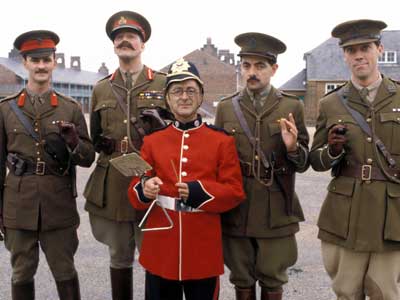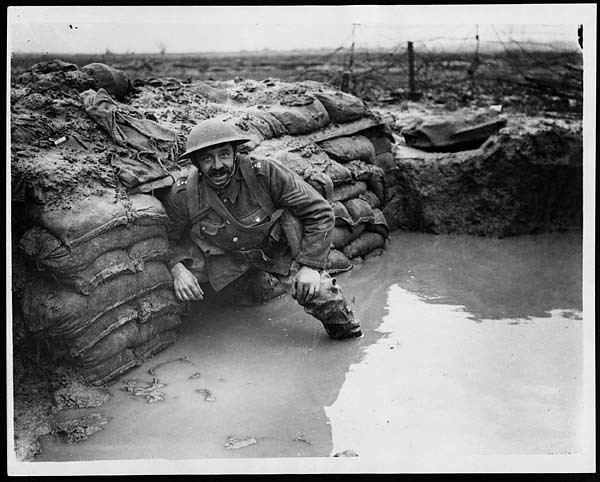One interesting remark I came across in Coppard's memoir was that a Jewish soldier in his regiment was allowed, in the spring of 1916, a week's home leave to attend Passover services. Many soldiers in the unit, according to Coppard, had not had any home leave since arriving in France. Coppard had, himself, been given about a week's compassionate home leave when his stepfather died at the beginning of 1916. That had been his first time back in England since embarking at Folkestone on 1 June1915.
In passing, I remark that Coppard had clearly read Robert Graves's Goodbye to All That, and read it very closely, before writing his own account of the war. Several times already (I'm about two-thirds through the short volume) he has mentioned Graves, either confirming his observations, remarking that their experiences were different, or questioning whether Graves quite understood some of the things he saw.
He has presented a pretty thorough impression of the attitudes towards the enemy in his unit. It began largely with a rather cautious dislike, the sort of instinctive but not very personal hostility that soldiers might have to an enemy they had not personally encountered. By the time they reach the winter of 1915/1916, however, he and his comrades had suffered enough from the attentions of the foe that there was no question of a Christmas Truce and, in fact, a positive willingness to take opportunities to kill the enemy. And when a group of German soldiers, under the pretense of surrendering, approached the British lines close enough to mount a devastating grenade attack, Coppard and others resolved simply to shoot any enemy in future that appeared to be attempting to surrender.
Friday, April 26, 2013
Tuesday, April 23, 2013
All Quiet, Apart from Scouting Reports
I'm continuing to read Anthony Saunders's Raiding on the Western Front, George Coppard's With machine gun to Cambrai [sic], and R. Derby Holmes's A Yankee in the Trenches. What strikes me most from the latter is the sheer misery of life in the trenches. This is hardly a surprise, given all that one reads and hears in general history about the war, but it should be emphasized that this is not one of the elements exaggerated by the broad-brush and traditional popular histories.
Both describe the rather miserable conditions to be found in those front-line British trenches without proper bunkers, where scrapes or perhaps slightly more commodious billets, still scarcely more than a large holes in the trench side, were dug. Forget some of the pretty pictures from later periods, or from further to the rear, where deep bunkers with walls, ceilings, floor, even rough furniture and venting systems are to be seen. These were just the sort of "nasty, dirty, wet hole, filled with the ends of worms and an oozy smell" that JRR Tolkein mentions in The Hobbit and with which the author was probably familiar himself during his service on the front line in 1916.
Both recount episodes where they were stationed in trenches that were either waterlogged or entirely flooded, with water (or, more properly, thin mud) up to their knees, hips, or waists. At one point, Coppard and his fellow machinegunners have to wade out to a small island which forms their forward gun position
Both encounter that staple of trench horror, the ever-present remains of fellow soldiers (of both armies), too omnipresent to remove for proper burial. As Coppard says, "So long as we were alive, we had to go on living, but it wasn't easy with the dead sandwiched so close to us. We took our meals and tried to sleep with them as our neighbours. Amid laughter and bawdy stories they were there."
Nor is the sheer incomprehensibility of actions taken at the command of higher headquarters blown seriously out of proportion in popular history. Several passages in Coppard's relation bear this home. One is his description of conditions in the Hohenzollern Redoubt in September 1915. Essentially, it was "a mass of pulverised dirt, ... no more than three or four acres" in size, with no visible value to either side, a moonscape of craters from artillery and exploded mines, almost indefensible, but which one side attempted to hold and the other side to possess, at the cost of hundreds, maybe thousands of lives.
In another example of somewhat incomprehensible activity, an artillery FO arrives, directs distant artillery to fire on a target behind the nearest enemy positions, and then departs. Of course, retaliatory enemy fire rains down on the front-line infantry who had merely served as bystanders.
What strikes me most from Saunders is the number of interesting actions that could be turned into wargame scenarios, and what a small proportion of the actual fighting they represent. An overwhelming amount of the combat activity that took place when troops were in the trenches was either simply random or near-random exchanges of fire or operations that might be more suitable as the subject of a roleplay episode or map exercise/kreigsspiel than a straight table-top battle. Patrol actions, especially, didn't have the sort of direct conflict that makes a good tabletop scenario, unless they went badly wrong. I'll provide a link here to a patrol report from the Royal Highlanders of Canada from 1916. It's an interesting expedition and certainly brought back useful intelligence, but the patrol leader was very careful to avoid contact and bring his men, and their intelligence, back in safety to their own lines. This could be a good one-sided exercise moderated by an umpire, but it wouldn't make for anything worth putting out terrain and figures.
Thursday, April 18, 2013
Life gets in the way!

Apologies to my hoard of readers (both of you ;-) for the break in communication. German shelling broke the telephone line from the OP in the forward sap. Or General Melchett had another smoking party in the officers' mess and now we have to get the cleaners in, replace all the furniture, and restock the Dow 1896 port.
Normal service should resume shortly.
Subscribe to:
Posts (Atom)




.jpg/400px-German_Barrage_Fire_at_Night_(Ypres).jpg)